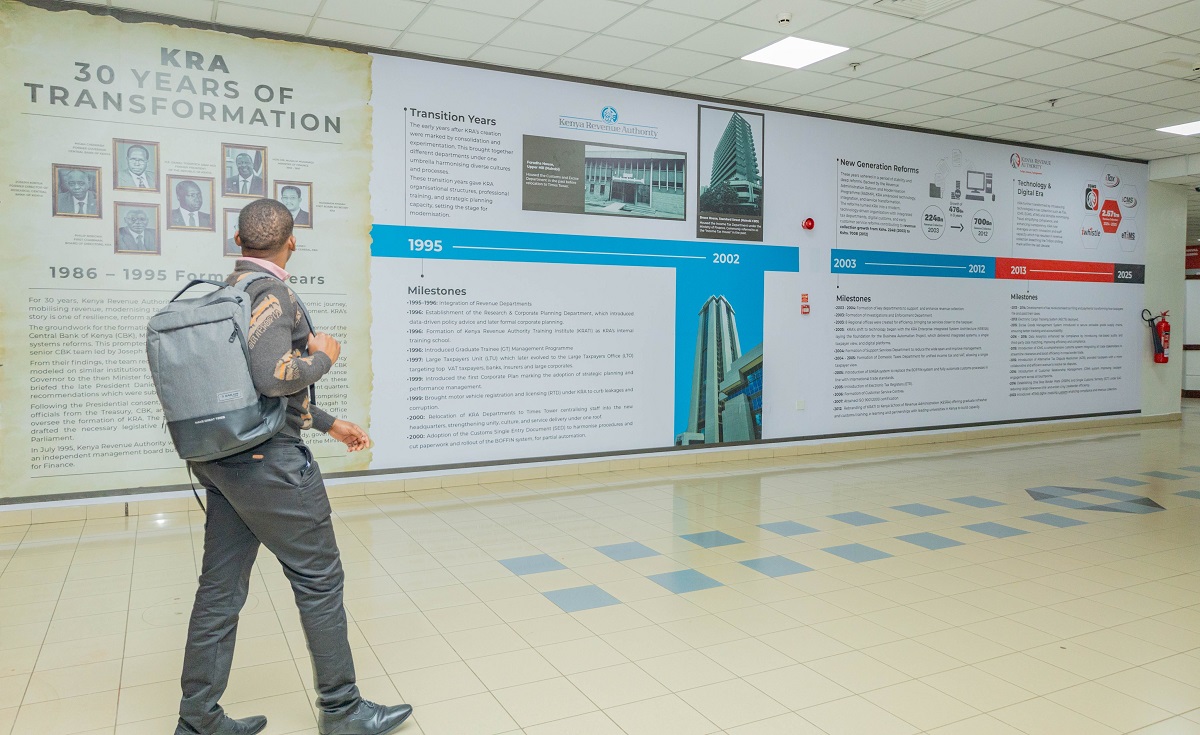KRA turns 30: Taxman’s digital shift push pays dividends as revenue collections edge up
- From an average of KES122 billion annual collections in mid 1990s, KRA’s tech-powered reforms have seen it collect over KES2.5 trillion in fiscal year 2024/25.
- KRA Commissioner-General Humphrey Wattanga says plans are underway to further to transform the agency into a premier service entity with enhanced digital capacity.
- Currently, the agency is aligning operations with a focus on tech to enhance compliance across Micro Small & Medium Enterprises (MSMEs) and emerging segments.
For 30 years, the Kenya Revenue Authority (KRA) has evolved from manual tax filing approach to a digital-first revenue monitoring, and compliance agency, driving the country’s annual collections from an average of $944.3 million (KES122 billion) in mid 1990s to over $19.35 billion (KES2.5 trillion) reported in fiscal year 2024/25.
While marking 30 years of service on Monday, KRA Commissioner-General Humphrey Wattanga announced that plans are underway to further to transform the agency into a premier service entity with enhanced digital capacity in service provision in a bold reform push that seeks to deploy more efficient revenue mobilization strategies.
“In the 1990s, tax administration was a challenge with multiple queues, duplicative forms, and unofficial ‘agents’ promising faster services for a fee. Our journey to modernization began gradually and has now blossomed into an ambitious strategic vision focused on tax simplification, technology-driven compliance, and tax base expansion,” the Commissioner-General Humphrey Wattanga said in Nairobi.
From an annual collection of approximately KES122.066 billion in the mid-90s, KRA surpassed the KES1 trillion milestone in the 2014/2015 financial year, collecting KES1.069 trillion.
By FY 2021/2022, powered by the adoption of technology and sealing of loopholes, revenue collections in Kenya more than doubled to KES2.031 trillion despite challenges posed by the COVID-19 pandemic economic fallout, and in the current fiscal year, KRA has already surpassed KES2.5 trillion in collections.
KRA’s Annual Revenue Performance for 2024/25 recorded collections of KES2.571 trillion, reflecting a 6.8 percent increase from FY2023/24. According to the agency, technology has empowered KRA to identify trends, enhance compliance, improve risk profiling, and forecast revenue with greater precision.
Key tech-based reforms that have driven up KRA’s collections
KRA’s bold early reforms set in between 2003 and 2012, a period when through the adoption of tech-based reforms and the streamlining of services, KRA managed to more than triple revenue collections.
In 2005 for instance, under the agency’s Revenue Administration Reform and Modernisation Programme (RARMP), KRA rolled out a customs automation system dubbed SIMBA 2005, replacing Border and Forwarding Financial Information Network (BOFFIN), a manual tax compliance and filing system.
2005 also saw the streamlining of KRA operations with the unification of the Domestic Taxes Department and Income Tax Department under one roof. What’s more, adoption of technology went a notch higher with the roll out of Electronic Tax Registers (ETRs) even as policy changes saw the acquisition of Personal Identification Numbers (PINs) become mandatory requirement across many government services.
Buoyed by these tech-based reforms, KRA experienced a massive increase in revenue collections under former President Mwai Kibaki’s government, with collections rising to KES700 billion per year from KES224 billion in 2003.
Read also: PwC, Deloitte Urge Realistic Revenue Goals and Efficient Public Spending in Kenya
KRA’s iTax, EGMS era of online suite of services
Soon after, KRA entered into another bold phase (2013 to 2019) of reforms and tech-based overhaul of service offering, marked by steady shift to more online services. The years 2013 to 2015 in particular, taxpayers in Kenya experienced the roll out of iTax systems, an online platform that allows individuals and businesses to file and pay their tax obligations virtually, a move that eliminated an annual practice where long winding queues of taxpayers into Times Tower every tail end of fiscal year.
At the same time, the Excise Goods Management System (EGMS) was implemented in 2015, offering KRA better leverage in monitoring tax compliance among players in Kenya’s alcohol, tobacco and excisable goods segment.
Additionally, in 2019 the Integrated Customs Management System (iCMS) entered the market, enabling the taxman to connects traders, transporters and government in one customs platform. It is also during this time when KRA enahnced its online tax service menu besides establishing one-stop border posts in Malaba, Busia, Namanga, and Moyale towns thereby simplify regional trade.
KRA’s latest phase (2020—2025) of tech-based reforms has been characterised by the adoption of emerging tools, e.g., Chatbots such as Shuru enhance taxpayer support, and GavaConnect, which is an API platform that aims at enabling businesses to integrate tax solutions into their systems.
Read also: Kenya’s debt repayment hits $3.7 billion amidst failed revenue targets
KRA — Key turning points in the agency’s 30-year journey
- 1995–1996: Integration of Revenue Departments
- 1996: Set up of Research & Corporate Planning Department, which introduced data-driven policy advice and later formal corporate planning.
- 1997: Large Taxpayers Unit (LTU) set up and later evolves into Large Taxpayers Office (LTO), targeting top VAT taxpayers, banks, insurers and large corporates.
- 1999: Brought motor vehicle registration and licensing (RTD) under KRA to seal leakages and corruption.
- 2000: Adoption of the Customs Single Entry Document (SED) to harmonise procedures and cut paperwork and rollout of the BOFFIN system, for partial automation.
- 2003: Eastablishment of Investigations and Enforcement Department. Opening of regional offices to enhance efficiency, bringing tax services closer to taxpayers.
- 2003: KRA’s shift to technology began with the KRA Enterprise Integrated System Architecture (KREISA), which delivered integrated systems, a single taxpayer view, and digital platforms.
- 2004—2005: Formation of Domestic Taxes Department for unified income tax and VAT, allowing a single taxpayer view.
- 2005: Introduction of SIMBA system to replace the BOFFIN system and fully automate customs processes in line with international trade standards. Introduction of Electronic Tax Registers (ETR).
- 2012: Rebranding of KRATI to Kenya School of Revenue Administration (KESRA) offering graduate refresher and customs training, e-learning and partnerships with leading universities in Kenya to build capacity.
- 2013—2014: Development of itax, revolutionising tax filing and payments. Electronic Cargo Tracking System (RECTS) deployed.
- 2015: Excise Goods Management System introduced to secure excisable goods supply chains, ensuring better tracking and accountability.
- 2016—2018: Data Analytics enhanced tax compliance by introducing risk-based audits and third-party data matching, improving efficiency and compliance.
- 2015: Introduction of iCMS, a customs system integrating all trade stakeholders to streamline clearance and boost efficiency in cross border trade.
- 2015: Introduction of Alternative Tax Dispute Resolution (ADR), provided taxpayers with a more collaborative and efficient avenue to resolve tax disputes.
- 2016: Establishing One Stop Border Posts (OSBPs) and Single Customs Territory (SCT) under EAC reducing cargo clearance time and enhancing cross-border efficiency.
- 2023: Introduced eTIMS digital invoicing systems enhancing compliance and revenue collection.
- 2024: Digital transformation driven by an enterprise Application Programming Interface (API) platform known as GavaConnect, fostering collaboration with IT developers to co-create simplified tax solutions that enhance the overall compliance experience. GavaConnect empowers businesses and taxpayers to integrate seamlessly and securely with KRA’s digital ecosystem, driving tax simplification and voluntary compliance.
- 2025: Realignment of internal operations with a focus on technology modernization, and targeted compliance support framework for Micro Small & Medium Enterprises (MSMEs) and emerging economies.
~ Milestones source: KRA; ($1 = KES129.2)
Share this content:





Post Comment